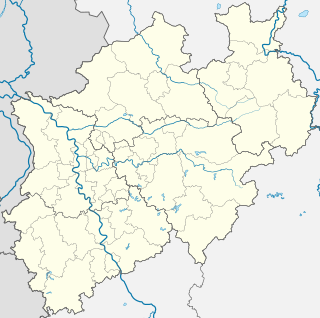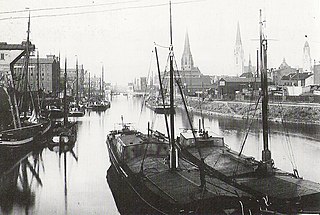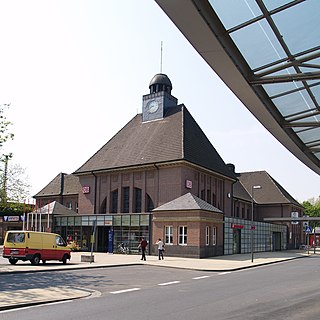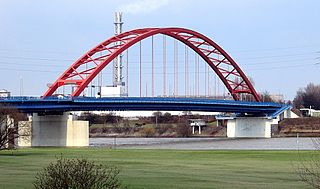Related Research Articles

The Ruhr, also referred to as Ruhr area, Ruhr district, Ruhr region, or Ruhr valley, is a polycentric urban area in North Rhine-Westphalia, Germany. With a population density of 2,800/km2 and a population of over 5 million (2017), it is the largest urban area in Germany. It consists of several large cities bordered by the rivers Ruhr to the south, Rhine to the west, and Lippe to the north. In the southwest it borders the Bergisches Land. It is considered part of the larger Rhine-Ruhr metropolitan region of more than 10 million people, which is among the largest in Europe.

Duisburg is a city in the Ruhr metropolitan area of the western German state of North Rhine-Westphalia. Lying on the confluence of the Rhine and the Ruhr rivers, Duisburg is one of the largest cities in the Ruhr and the 15th-largest city in Germany.

Schwerte is a town in the district of Unna, in North Rhine-Westphalia, Germany.

Waldalgesheim is an Ortsgemeinde – a municipality belonging to a Verbandsgemeinde, a kind of collective municipality – in the Mainz-Bingen district in Rhineland-Palatinate, Germany. It is best known as the site of the Iron Age Waldalgesheim chariot burial.

The Rhine–Herne Canal is a 45.6-kilometre-long (28.3 mi) transportation canal in the Ruhr area of North Rhine-Westphalia, Germany, with five canal locks. The canal was built over a period of eight years and connects the harbour in Duisburg on the Rhine with the Dortmund-Ems Canal near Henrichenburg, following the valley of the Emscher. It was widened in the 1980s. The Rhein-Herne canal ship was designed specifically for this canal; normally of about 1300–1350 ton capacity, it has a maximum draft of 2.50 metres (8.2 ft), a length of approximately 80 metres (260 ft), and maximum beam of 9.50 metres (31.2 ft).

Hagen Hauptbahnhof is a railway station serving the city of Hagen in western Germany. It is an important rail hub for the southeastern Ruhr area, offering regional and long distance connections. The station was opened in 1848 as part of the Bergisch-Märkische Railway Company's Elberfeld–Dortmund line and is one of the few stations in the Ruhr valley to retain its original station hall, which dates back to 1910.

Duisburg Hauptbahnhof is a railway station in the city of Duisburg in western Germany. It is situated at the meeting point of many important national and international railway lines in the Northwestern Ruhr valley.
The European Route of Industrial Heritage (ERIH) is a tourist route of the most important industrial heritage sites in Europe. This is a tourism industry information initiative to present a network of industrial heritage sites across Europe. The aim of the project is to create interest for the common European heritage of the Industrialisation and its legacy. ERIH also wants to promote regions, towns and sites showing the industrial history and market them as visitor attractions in the leisure and tourism industry.

The Eisenbahnmuseum Bochum-Dahlhausen is a railway museum situated south of the city of Bochum in the state of North Rhine-Westphalia, Germany. It was founded by DGEG, the German Railway History Company in 1977 and is based in a locomotive depot that was built between 1916 and 1918 and ceased operation in 1969. Then DGEG took over the whole area of 46,000 square metres and built up the biggest railway museum in Germany. In the middle of the museum, there is an engine shed with fourteen tracks. A preserved turntable, coaling, watering, and sanding facilities are still in operation. This museum is integrated into The Industrial Heritage Trail a route of monuments from the history of the industry.

Oberhausen Hauptbahnhof is a railway station in Oberhausen, North Rhine-Westphalia, Germany. The station was opened in 1847 and is located on the Duisburg–Dortmund railway, Arnhem-Oberhausen railway, Oberhausen–Duisburg-Ruhrort railway and Oberhausen-Mülheim-Styrum railway and is served by ICE, IC, RE and RB services operated by Deutsche Bahn, Abellio Deutschland, NordWestBahn and Eurobahn.

Witten Hauptbahnhof is a railway station in the town of Witten in western Germany. It is situated southwest of the town.

The Eisenbahn und Häfen GmbH is a service company providing rail transportation and associated storage as well as operating the Rhine ports of Schwelgern and Walsum-Süd.

The Industrial Heritage Trail links tourist attractions related to the industrial heritage in the Ruhr area in Germany. It is a part of the European Route of Industrial Heritage. The series of routes were developed between 1989 and 1999, however additions are still being made.

The Innenhafen in Duisburg, Germany, is connected to the Rhine River, encompasses an area of 89ha. For over a hundred years during the high point of the Industrial Revolution, it was the central harbour and trading point of the town. Since the mid 1960s, the importance of the harbour declined and it lay in a disused condition for 20 years, before plans for renovation were drawn up. This former industrial area has been fundamentally transformed, a process which started as a part of the International Building Exhibition Emscher Park (IBA) which ran from 1989 until 1999.
Duisburg: Town and Harbour is the Theme Route No. 1 of the Industrial Heritage Trail, which passes through Duisburg, the Inner Harbour, Ruhrort, the Duisburg-Ruhrorter harbour and other attractions on the Rhine and Ruhr. These trails were first developed between 1989 and 1999.

Herne station was opened in the inner city of Herne in the German state of North Rhine-Westphalia in 1847 together with the Cologne-Minden trunk line. It was located between the village of Herne, which had about 1,000 inhabitants, and the moated castle of Schloss Strünkede and was south of the current station on Von-der-Heydt-Strasse. It soon had a connection to the more southerly city of Bochum, which until 14 years later did not have its own station. For this reason the station was called Herne-Bochum until 1855.

Essen-Steele Ost station is located in the district of Essen-Steele in the German city of Essen in the German state of North Rhine-Westphalia. It is on the Witten/Dortmund–Oberhausen/Duisburg line and is classified by Deutsche Bahn as a category 4 station. It is served by Rhine-Ruhr S-Bahn lines S 1 and S 3.

Hattersheim (Main) station is together with Hattersheim-Eddersheim station one of two S-Bahn stops in the town of Hattersheim, southwest of Frankfurt in the German state of Hesse. Both stations lie on the Taunus Railway from Wiesbaden to Frankfurt. The station is classified by Deutsche Bahn as a category 4 station.

Dortmund-Huckarde Nord (north) station is a passenger station in the Dortmund district of Huckarde in the German state of North Rhine-Westphalia. It is classified by Deutsche Bahn as a category 7 station.

The Bridge of Solidarity is a bridge across the Rhine between the boroughs of Rheinhausen and Hochfeld in the city of Duisburg.
References
- Martina Will: Duisburg: Industriekultur am Rhein. (Themenroute 3 der "Route der Industriekultur"). Kommunalverband Ruhrgebiet, Essen. 1999. 96 S. (Broschüre)
